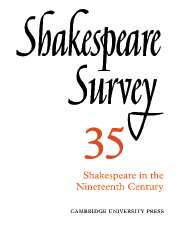Book contents
- Frontmatter
- Before the Shakespeare Revolution: Developments in the Study of Nineteenth-Century Shakespearian Production
- The Meininger Company and English Shakespeare
- Shakespeare at the Burgtheater: From Heinrich Anschütz to Josef Kainz
- Shakespeare on the Melbourne Stage, 1843-61
- Shakespeare in Hazlitt’s Theatre Criticism
- Characterization of the Four Young Lovers in A Midsummer Night’s Dream
- Queenly Shadows: On Mediation in Two Comedies
- Language, Theme, and Character in Twelfth Night
- The Art of the Comic Duologue in Three Plays by Shakespeare
- ‘Spanish’ Othello: The Making of Shakespeare’s Moor
- Ferdinand and Miranda at Chess
- Shakespeare’s Latin Citations: The Editorial Problem
- The Theatre at Christ Church, Oxford, in 1605
- Interpretations of Shakespearian Comedy, 1981
- The Year's Contributions to Shakespearian Study 1 Critical Studies
- 2 Shakespeare’s Life, Times and Stage
- 3 Textual Studies
- Index
- Plate Section
Shakespeare on the Melbourne Stage, 1843-61
Published online by Cambridge University Press: 28 March 2007
- Frontmatter
- Before the Shakespeare Revolution: Developments in the Study of Nineteenth-Century Shakespearian Production
- The Meininger Company and English Shakespeare
- Shakespeare at the Burgtheater: From Heinrich Anschütz to Josef Kainz
- Shakespeare on the Melbourne Stage, 1843-61
- Shakespeare in Hazlitt’s Theatre Criticism
- Characterization of the Four Young Lovers in A Midsummer Night’s Dream
- Queenly Shadows: On Mediation in Two Comedies
- Language, Theme, and Character in Twelfth Night
- The Art of the Comic Duologue in Three Plays by Shakespeare
- ‘Spanish’ Othello: The Making of Shakespeare’s Moor
- Ferdinand and Miranda at Chess
- Shakespeare’s Latin Citations: The Editorial Problem
- The Theatre at Christ Church, Oxford, in 1605
- Interpretations of Shakespearian Comedy, 1981
- The Year's Contributions to Shakespearian Study 1 Critical Studies
- 2 Shakespeare’s Life, Times and Stage
- 3 Textual Studies
- Index
- Plate Section
Summary
Barely ten years after John Batman, one of the first settlers in Victoria, had made a treaty with the aborigines which the central government a few years later decided to ignore, Othello was played in Melbourne. It was the first Shakespeare play to be staged in the colony, on 4 September 1843, under the management of Conrad Knowles, in a wooden shed in Bourke Street which seated 500 and was called the Pavilion. It was astonishing that Shakespeare was produced at all, for instead of the ‘fashionable’ house that The Port Phillip Gazette anticipated, Knowles had to contend with wild, unruly audiences. When he played Shylock in September ‘certain parties were refused admission to the dress circle’. This was the Yahoo period of Australian stage history when barbarism reigned triumphant.
The hope that more 'fashionable' audiences might turn up led to the construction of a new playhouse at the corner of Little Bourke and Queen Street, begun in August, 1843, and completed with tortoise-like speed in 1845. Francis Nesbitt, the best-known Shakespearian actor of the day after Knowles, became its manager. The Queen's Theatre, larger than the Pavilion, could hold 800 persons; by London standards it was considered a 'little theatre', but for the next eight years it changed nothing. Audiences remained buoyantly insensitive.
- Type
- Chapter
- Information
- Shakespeare Survey , pp. 31 - 42Publisher: Cambridge University PressPrint publication year: 1982
- 1
- Cited by

